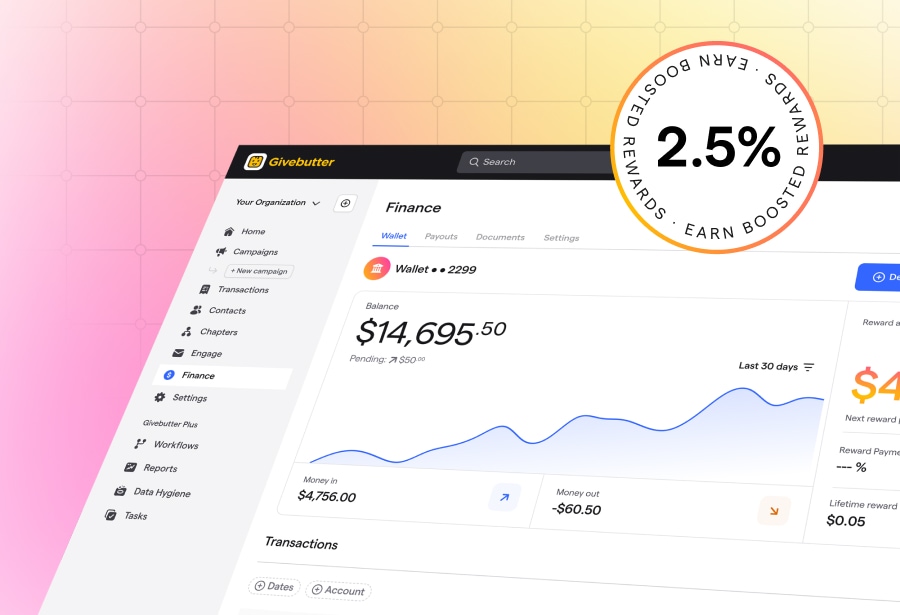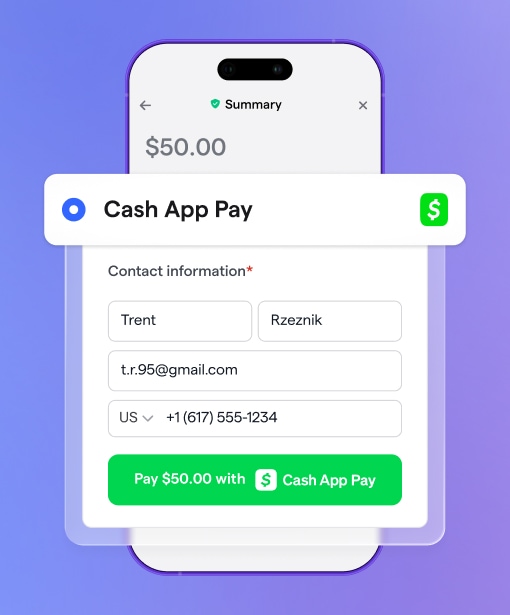Table of contents
Table of contents
By 2030, experts expect corporate giving to reach $189.5B. While companies contribute in many ways, corporate sponsorships are among the most significant.
To jumpstart your corporate sponsorship strategy, dive into our guide below. We’ll help you find the right companies to reach out to and how to pitch to them with a step-by-step guide and examples—so you can start getting donations from companies in no time.
Key takeaways
- Understand your sponsorship goals 🥅 Clarify what you hope to gain from corporate sponsorship—financial support, in-kind donations, both—and your specific goal (for the year, quarter, event, etc.).
- Create your sponsorship program 📝 Outline how you’ll handle outreach, follow-ups, and acknowledgment. Designate staff, prepare internal documents, and structure your sponsorship packages.
- Build your prospect list 🔎 Identify potential sponsors who care about your cause, community, or audience. Prioritize companies whose values align with yours.
- Write and send your appeal 🚀 Keep your request short and compelling. Highlight perks, personalize your outreach, and track communications using a CRM.
- Deliver, report, and renew 🔄 Follow through on any promised benefits, share impact updates, and nurture long-term relationships.
- Manage your corporate sponsorships with Givebutter 🧈 Track sponsors, automate tasks and workflows, and more—Givebutter does all the heavy lifting so you can focus on what really matters.
What is corporate sponsorship?
Corporate sponsorship is when a business provides financial or in-kind support to a nonprofit in exchange for agreed-upon recognition. Common benefits for companies include:
- Brand recognition ⭐ Nonprofits display sponsorship logos on promotional materials, merchandise, or event materials.
- Positive press 📣 Corporations can enhance their public image when they are seen supporting nonprofit causes.
- Tax incentives 💸 Businesses can deduct as much as 25% of their taxable income for contributions to nonprofits with tax-exempt status, according to IRS guidelines.
What are the best corporate sponsorship benefits for nonprofits?
The top ten most generous corporations donate over $2B a year. Beyond bringing funds in the door, corporate sponsorship has several key benefits for nonprofits:
- Visibility ✨ Associating with well-known corporations can enhance a nonprofit's credibility and raise awareness of its mission and initiatives.
- Access to resources 🎁 Corporate sponsors may offer volunteer assistance or professional guidance.
- Networking opportunities 🤝 Sponsorships can lead to long-term collaborations, which could result in access to other organizations, new donors, and a broader volunteer network.
What are the main types of corporate sponsorships?
There are several types of corporate sponsorships, each serving a unique purpose and offering mutually beneficial opportunities to both nonprofits and businesses.

- Contributing funds 💰 Whether given as a lump sum or in smaller payments, a monetary donation is often the simplest way for businesses to contribute. Nonprofits typically charge sponsorship fees in this kind of arrangement.
- Providing in-kind donations 🛍 Businesses may also donate products and services, like t-shirts, event tickets, prize packages, auction baskets, or catering services.
- Covering marketing costs 📢 A corporate sponsor can contribute toward your marketing and advertising expenses, or cover the cost entirely—TV or social media ads, printed promotional materials, and more.
- Encouraging employee participation 👷 Many businesses encourage their staff to support the nonprofit’s cause through methods like automatic payroll deductions for donations and corporate matching gifts.
How to get corporate sponsors in 5 steps
Follow these five steps to zero in on sponsorship candidates and demonstrate how partnering with your organization is good for business.
Step 1: Get clear on your goals 🔍
Before approaching potential partners, reflect on your mission and goals to ensure you put your best foot forward. Make sure you can clearly answer the following questions:
- What is your fundraising goal (for the year, quarter, event, etc.)?
- What do you hope to gain from a corporate sponsorship? Financial support? In-kind donations?
- Are you seeking a one-off nonprofit event sponsorship or a long-term agreement?
- Who is your target audience for donations and volunteers?
- What is your unique value proposition?
Step 2. Craft your sponsorship program 💭
Complete these tasks to build a strong and organized sponsorship program:
- Create a workflow 🤝 Develop a plan for initial outreach, follow-up requests, and support acknowledgment.
- Designate staff for sponsorships 👥 Decide who will take the lead on managing these relationships, whether it’s a board member, intern, or another team member.
- Prepare your internal documents 📋 Compile the impact stories, achievements, and data that showcase your organization.
- Develop your corporate sponsorship packages 🎁 Establish your sponsorship levels and the benefits for each. Create a dedicated sponsorship page on your website and a detailed handout to accompany it.
Step 3: Create a list of corporate sponsors 👥
The best corporate sponsors have a reputable brand and share your organization’s core values and goals. Make a list of potential sponsors that fit into one of these three categories:
- Those who care about your cause 💛 Research other causes your potential sponsors have supported. Maybe your mission aligns with their interests and passions.
- Those who care about others impacted by your mission 🫂 For causes like cancer awareness, seek out business owners who are survivors or have loved ones affected by the illness.
- Those who share your target audience 📣 Are you raising money for a local club or school sports team? Make a list of every athletics store and organization in the area.
Step 4. Craft a strong appeal 📩
Once you have your prospect list, it’s time to write your pitch. Your proposal should be clear, concise, and engaging—explain what the opportunity is, why you’re asking, and how it benefits them.
Here’s how to get started:
- Keep design in mind 🎨 Limit your request to a single, easily skimmable page—highlight specific programs, key impact, and enticing benefits.
- Get creative 🌟 If you really want to stand out amongst other nonprofits, think outside the box when it comes to perks. Will local press or social media influencers attend your event? Can you give away branded merchandise from your sponsor?
- Send and track 📊 Use a CRM to organize your sponsor email list and monitor your outreach—track contact info, activity (emails, phone calls, etc.), and donation history.
💡 Pro tip: Reach out by email or phone every few days, and be prepared to discuss details when you connect with a decision-maker. Don’t be discouraged by rejection—you can always send another request in the future.
Step 5: Deliver, report, and renew 💛
If you've received a corporate donation, congrats! Now comes the work of making your corporate sponsor an integral part of your community—not just a one-time donor.
To create long-standing partnerships with corporate donors, be sure to:
- Deliver on what you promised ✅ Be sure to follow through on any benefits you promised—whether that’s adding their logo to your website or posting about them on social media.
- Report on the impact 📊 Send corporate donors evidence of their impact, either through beneficiary testimonials, photos and videos, or even personalized reports.
- Continue to connect 🤝 Once the terms of the sponsorship are completed, your work isn't quite done! Nurture relationships with your sponsors by continuing to show appreciation—like social media shoutouts and handwritten thank-you notes.
The most popular corporate sponsorship examples
Corporate partnerships can take many forms depending on your mission and the company’s resources and goals. However, there are some common ways you might use a corporate sponsorship:
- Organize a 5K race 👟 For your walk/run fundraiser, a sponsor provides prizes for the top finishers in each age group. In exchange, you feature their name on race t-shirts.
- Deliver meals to those in need 🍲 Your nonprofit partners with a local business to cover expenses for delivering meals to seniors. You display their logo on your delivery vehicles, giving them positive community visibility.
- Host a golf tournament 🏌 You organize a golf tournament with nine sponsorship slots—one for each hole on the green. Businesses can decorate their booth, sell new products, and help create a memorable event experience.
- Present a school musical 🎭 Your high school drama department stages a spring production with a local insurance agency as the title sponsor. They cover costume rental costs and receive full-page program ads, lobby signage, and recognition in curtain call announcements.
- Host a science fair 🔬 Your middle school partners with a tech company to sponsor your annual science fair. In return, they receive recognition in school communications, parent emails, and event displays.
Manage your corporate sponsors with Givebutter
Securing donations from companies is all about building strong, long-term relationships. Don't let your outreach strategy become a burn-and-churn process—conduct thorough research, craft personalized emails, and design creative proposals to truly stand out.
Givebutter makes this process smooth and straightforward. With a free CRM for tracking sponsors, automated tasks and workflows for handling your to-dos, reports, and dashboards for measuring sponsorship impact and ROI, and so much more, Givebutter handles all the heavy lifting so you don't have to.

Use Givebutter workflows to streamline outreach
Create a free Givebutter account today and set your nonprofit on the path to fundraising and corporate sponsorship success.
FAQs about how to get corporate sponsors
Is corporate sponsorship a donation?
While donations are primarily philanthropic, corporate sponsorship is a mutually beneficial business exchange where both parties receive value. Sponsors provide financial or in-kind support, and the nonprofit offers tangible benefits in return—like logo placement, recognition at events, or social media mentions.
It’s also important to note that for tax purposes, sponsorships are often treated differently from charitable donations.
How much do corporate sponsors pay?
Sponsorship amounts can vary widely. Smaller fundraising events may secure $500–$5K, while national nonprofits often receive $25K–$100K+ from major corporations. Your nonprofit’s total will depend on factors like your audience size, sponsorship benefits offered, and the corporate partner's size and budget.
Are corporate sponsorships tax-deductible?
Corporate sponsorships can be tax-deductible, but how they’re reported to the IRS depends on whether the business receives benefits in return.
If a company receives promotional value (like advertising), the contribution might be considered a business expense. If no substantial benefits are provided, it may be classified as a charitable contribution. Both are fully tax-deductible.
To determine whether your corporate sponsorship is tax-deductible or not, be sure to consult a tax professional.
Who to contact for corporate sponsorship?
For a small business, reach out directly to the owner or general manager by email, phone, or in person. For larger corporations, contact the corporate philanthropy department, community relations manager, or corporate social responsibility (CSR) team.
How to get corporate sponsorship for a sports team?
Identify local businesses whose audience overlaps with yours—such as sporting goods stores or fitness centers. Then send a tailored sponsorship proposal outlining different tiers, prices, and benefits (e.g., logos on jerseys, banners, or team websites).
How to get corporate sponsorship for an event?
Reach out to businesses whose target customers match your event attendees. Then, create a clear sponsorship proposal that includes your event details, expected attendance, and, most importantly, the benefits that sponsors will receive, such as a brand feature or speaking opportunities.
.svg)






%20(1).png)



.svg)















